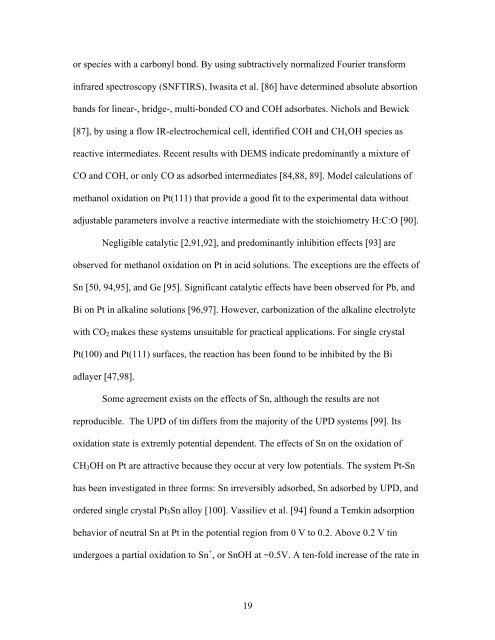electrocatalysis on surfaces modified... - Brookhaven National ...
electrocatalysis on surfaces modified... - Brookhaven National ...
electrocatalysis on surfaces modified... - Brookhaven National ...
Create successful ePaper yourself
Turn your PDF publications into a flip-book with our unique Google optimized e-Paper software.
or species with a carb<strong>on</strong>yl b<strong>on</strong>d. By using subtractively normalized Fourier transform<br />
infrared spectroscopy (SNFTIRS), Iwasita et al. [86] have determined absolute absorti<strong>on</strong><br />
bands for linear-, bridge-, multi-b<strong>on</strong>ded CO and COH adsorbates. Nichols and Bewick<br />
[87], by using a flow IR-electrochemical cell, identified COH and CH x OH species as<br />
reactive intermediates. Recent results with DEMS indicate predominantly a mixture of<br />
CO and COH, or <strong>on</strong>ly CO as adsorbed intermediates [84,88, 89]. Model calculati<strong>on</strong>s of<br />
methanol oxidati<strong>on</strong> <strong>on</strong> Pt(111) that provide a good fit to the experimental data without<br />
adjustable parameters involve a reactive intermediate with the stoichiometry H:C:O [90].<br />
Negligible catalytic [2,91,92], and predominantly inhibiti<strong>on</strong> effects [93] are<br />
observed for methanol oxidati<strong>on</strong> <strong>on</strong> Pt in acid soluti<strong>on</strong>s. The excepti<strong>on</strong>s are the effects of<br />
Sn [50, 94,95], and Ge [95]. Significant catalytic effects have been observed for Pb, and<br />
Bi <strong>on</strong> Pt in alkaline soluti<strong>on</strong>s [96,97]. However, carb<strong>on</strong>izati<strong>on</strong> of the alkaline electrolyte<br />
with CO 2 makes these systems unsuitable for practical applicati<strong>on</strong>s. For single crystal<br />
Pt(100) and Pt(111) <strong>surfaces</strong>, the reacti<strong>on</strong> has been found to be inhibited by the Bi<br />
adlayer [47,98].<br />
Some agreement exists <strong>on</strong> the effects of Sn, although the results are not<br />
reproducible. The UPD of tin differs from the majority of the UPD systems [99]. Its<br />
oxidati<strong>on</strong> state is extremly potential dependent. The effects of Sn <strong>on</strong> the oxidati<strong>on</strong> of<br />
CH 3 OH <strong>on</strong> Pt are attractive because they occur at very low potentials. The system Pt-Sn<br />
has been investigated in three forms: Sn irreversibly adsorbed, Sn adsorbed by UPD, and<br />
ordered single crystal Pt 3 Sn alloy [100]. Vassiliev et al. [94] found a Temkin adsorpti<strong>on</strong><br />
behavior of neutral Sn at Pt in the potential regi<strong>on</strong> from 0 V to 0.2. Above 0.2 V tin<br />
undergoes a partial oxidati<strong>on</strong> to Sn + , or SnOH at ~0.5V. A ten-fold increase of the rate in<br />
19
















